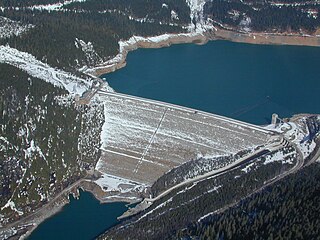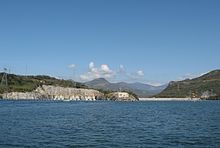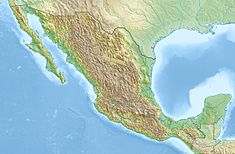
Falcon Dam is an earthen embankment dam on the Rio Grande between Starr County in the U.S. state of Texas and the city of Nueva Ciudad Guerrero in the Mexican state of Tamaulipas. The dam was built for water conservation, irrigation, hydroelectric power generation, flood control, and recreational purposes and as an international border crossing between Zapata and Starr Counties and Tamaulipas. Construction on the dam began in December 1950 and ended in April 1954 but it was dedicated by presidents Adolfo Ruiz Cortines and Dwight D. Eisenhower in October 1953.

The Tokuyama Dam is an embankment dam near Ibigawa, Ibi District, Gifu Prefecture in Japan. The dam was completed in 2008 and will support a 153 MW hydroelectric power station that is expected to be fully operational in 2015. Currently, Unit 1 at 23 MW was commissioned in May 2014. The dam was originally intended to withhold the upper reservoir of a 400 MW pumped-storage power station until a design change in 2004. The dam is also intended for flood control and water supply. It is the largest dam by structural volume in Japan and withholds the country's largest reservoir by volume as well.

Nuozhadu Dam is an embankment dam on the Lancang (Mekong) River in Yunnan Province, southwest China. The dam is 261.5 m (858 ft) tall, and creates a reservoir with a normal capacity of 21,749,000,000 m3 (17,632,000 acre⋅ft) at a level of 812 m (2,664 ft) asl. The purpose of the dam is hydroelectric power production along with flood control and navigation. The dam supports a power station with nine generators, each with generating capacity of 650 MW. The total generating capacity of the power station is 5,850 MW. Construction on the project began in 2004; the dam's first generator went online 6 September 2012 and the last generator was commissioned in June 2014. The construction and management of the project was implemented by Huaneng Power International Ltd., which has a concession to build, own and operate hydroelectric dams on China's stretch of the Mekong River.

The Shuibuya Dam is a concrete-face rock-fill embankment dam on the Qingjiang River in Badong County, Enshi, Hubei Province, China. The purpose of the dam is mainly hydroelectricity but it also promotes flood control, navigation, tourism and fishery. At 233 m (764 ft) tall and containing 15,640,000 m3 (20,460,000 cu yd) of material, it is the tallest concrete face rock-fill dam in the world.

The Peñitas Dam, also known as Ángel Albino Corzo, is a dam with a hydro-electric power station on the river Rio Grijalva, 83 km south west of the city of Villahermosa, lying in the municipality of Ostuacán in the state of Chiapas in southern Mexico. The power station has an installed production effect of 420 MW from four turbines, and an annual production of 2.035 TWh.

The Salto Santiago Hydroelectric Power Plant is a dam and hydroelectric power plant on the Iguazu River near Santiago in Paraná, Brazil. It is the third dam upstream of the Iguazu Falls and was completed in 1979. The power station has a 1,420 MW capacity and is supplied with water by a rock-fill embankment dam.

The Água Vermelha Dam is an embankment dam on the Grande River near Iturama in Minas Gerais/São Paulo, Brazil. It was constructed for hydroelectric power production and flood control. Construction on the dam began in 1973 and it was completed and operational by 1978. The last generators were operational in 1979.

The Guanyinyan Dam is a gravity dam on the Jinsha River 30 km (19 mi) southwest of Panzhihua on the border of Yunnan and Sichuan Provinces in China. The purpose of the dam is hydroelectric power generation and flood control. Construction on the dam started in 2008 and the river was diverted by 2010. The first generator was operational on 20 December 2014 and the fourth on 14 December 2015. The entire power station should be operational by 2016. When complete, the dam will support a 3,000 MW power station consisting of five 600 MW Francis turbine generators.

The Jishixia Dam is a concrete face rock-fill embankment dam on the Yellow River in Qinghai Province, China. It is 101 m (331 ft) tall and downstream from the Gongboxia Dam. The purpose of the dam is hydroelectric power generation and flood control. The dam supports a power station with 3 x 340 MW Francis turbines for a total installed capacity of 1,020 MW. Construction on the dam began in 2005 and the river was diverted in March 2007. The first generator was operational in mid-2010 and the rest by the end of the year.

The Silin Dam is a concrete gravity dam on the Wu River in Sinan County, Guizhou Province, China. The dam has an associated hydroelectric power plant with a 1,080 MW capacity utilizing 4 x 270 MW Francis turbine-generators. The dam is 310 m (1,017 ft) long, 117 m (384 ft) high and composed of roller-compacted concrete. Its reservoir has a 1,205,000,000 m3 (976,909 acre⋅ft) capacity, 184,000,000 m3 (149,171 acre⋅ft) of which is flood storage. The dam also supports ship lift. Construction on the dam began in October 2004, the dam began to impound the river in March 2008 and by May 2009, the power plant's first generator was operational. The remaining generators were operational by December 2009.

The Wujiangdu Dam is an arch-gravity dam on the Wu River south of Zunyi, Guizhou Province, China. The purpose of the dam is hydroelectric power generation, flood control and navigation. The dam's power stations contain five generators for a total installed capacity of 1,130 MW.

The Votkinsk Hydroelectric Station is a dam and hydroelectric power station on the Kama River along the border of Perm Krai and Udmurtia, Russia. It is 30 km (19 mi) south of Votkinsk and its main purpose is power generation and navigation. The power station has a 1,020 MW installed capacity and the dam also supports a ship lift. Construction on the dam began in 1955, the first generator was operational in 1961 and the last in 1963. The entire project was complete in 1965.

The Infiernillo Dam, also known as Adolfo López Mateos Dam, is an embankment dam on the Balsas River near La Unión, Guerrero, Mexico. The dam supports a hydroelectric power station containing six turbine-generators for a total installed capacity of 1,120 MW. The dam is 149 m (489 ft) high, 344 m (1,129 ft) long and is owned by Comisión Federal de Electricidad. Its first generator was operational on January 25, 1965.

The Angostura Dam is an embankment dam and hydroelectric power station on the Grijalva River near Venustiano Carranza in Chiapas, Mexico. The dam's power plant contains 5 x 180 MW, 3 x 310 MW Francis turbine-generators. The 146 m (479 ft) tall dam withholds one of the largest reservoirs in Mexico of 18,200,000,000 m3 (14,754,980 acre⋅ft). Initial construction on the dam began in 1969 and foundation work in 1971. On May 8, 1974, the dam began to impound its reservoir. On 14 July 1976, the dam's first generator went online.

The Aguamilpa Dam is an embankment dam on the Río Grande de Santiago in the Mexican state of Nayarit, 38 km (24 mi) northeast of Tepic. The primary purpose of the dam is hydroelectric power generation and it supplies a 960 MW power station with water. Construction on the dam began in 1989 and it was completed in 1993 while the power station became operational in 1994.

Stave Falls Dam is a dual-dam power complex on the Stave River in Stave Falls, British Columbia, Canada. The dam was completed in 1912 for the primary purpose of hydroelectric power production. To increase the capacity of Stave Lake, the dam was raised in 1925 and the Blind Slough Dam constructed in an adjacent watercourse 500 m (1,600 ft) to the north, which was the site of the eponymous Stave Falls. In 2000, the dam's powerhouse was replaced after a four-year upgrade. The powerhouse was once British Columbia's largest hydroelectric power source and is a National Historic Site of Canada.

The Tankeng Dam is a concrete-face rock-fill embankment dam on the Ou River located 24 km (15 mi) west of Qingtian, Zhejiang Province, China. The main purpose of the dam is hydroelectric power generation but it also provides for flood control, irrigation, and tourism. The 162 m (531 ft) tall dam creates a reservoir with a maximum capacity of 4,190,000,000 m3 (3,396,888 acre⋅ft). The power station contains 3 x 200 MW Francis turbine-generators for a total installed capacity of 600 MW. The dam was planned beginning in the early 1980s and approved in May 2003. Construction on the dam began that same year and in April 2008, the dam began to impound the river. On 15 August 2008, the first generator became operational, the second on 12 January 2009 and the third on 10 July 2009.

The Daguangba Dam is a multi-purpose dam on the Changhua River in Hainan Province, China. It is located 35 km (22 mi) east of Dongfang. As the primary component of the Daguangba Multipurpose Project, the dam was constructed between 1990 and 1995. It serves to provide water for both hydroelectric power generation and agriculture. It supports a 240 MW power station and supplies water for the irrigation of 12,700 ha. It is also the largest dam and hydroelectric power station in Hainan.

The Saguling Dam is an embankment dam on the headwater of Citarum River in West Java, Indonesia. It is located 26 km (16 mi) west of Bandung. Construction began in 1983. The reservoir had filled by 1985 and the first generator was operational in 1986. The primary purpose of the dam is hydroelectric power generation but it also provides for water supply and aquaculture. The 99 m (325 ft) tall dam is rock-fill embankment-type with watertight core that withholds a reservoir with a capacity of 2,750,000,000 m3 (2,229,461 acre⋅ft). Its power station has 4 x 175 MW Francis turbine generators with an installed capacity of 700 MW. Including land acquisition, the cost of the dam with power plant was about $US 663 million. The installed capacity of the power plant might be expanded to 1,400 MW in the future. The construction of the dam resulted in displacement of nearly 60,000 people.

The Kayrakkum Dam, also spelt variously as Kayrakum, Kairakum, Qayraqqum or Qayroqqum, is an embankment dam on the Syr Darya River near the town of Kayrakkum in Sughd Province, Tajikistan. It is situated on the western edge of the Fergana Valley and creates Kayrakkum Reservoir. The reservoir supplies water for irrigation, primarily in Uzbekistan downstream, and hydroelectric power production. The reservoir is also a Ramsar site. The dam's power station has an installed capacity of 126 MW and is operated by Barki Tojik. Construction on the dam began in 1952. It began to impound its reservoir in 1956 and the first two generators were commissioned that year. The other four were operational in 1957 and the project was complete in 1959. The power station is currently undergoing a rehabilitation which should be completed in 2020. Two new and larger turbines will increase the installed capacity to 142 MW.















